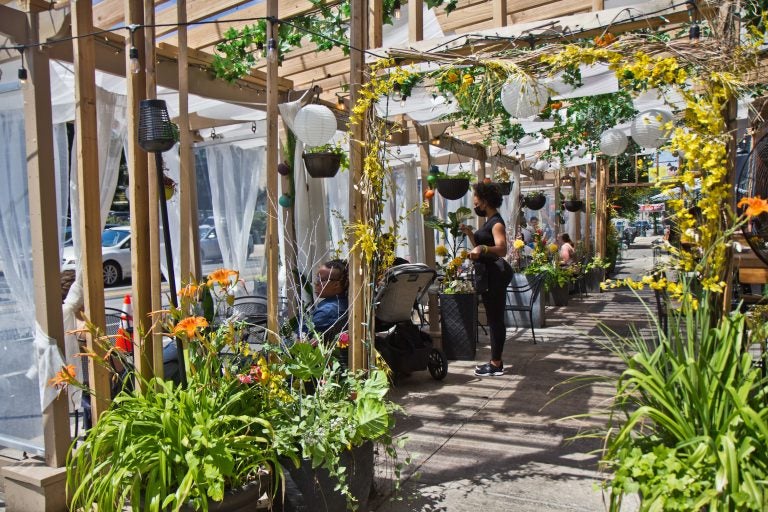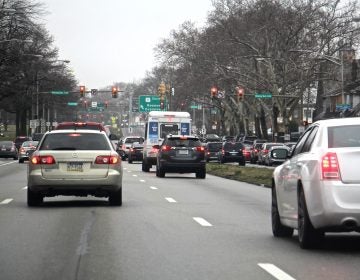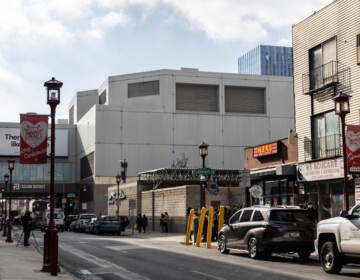More parklets, plazas, and streeteries: Why now is the time for Philly to invest in making our streets safer and better
It’s time for Philadelphia to invest in solutions that will make our city’s public spaces safer, more equitable, and enjoyable for all, writes Ariel Ben-Amos.

Outdoor dining at Booker’s restaurant in West Philadelphia. (Kimberly Paynter/WHYY)
Next year, Philadelphia will choose a new mayor, and its City Council will have an influx of new members. So now is the time to remember that these streets are our streets, that the city should make it easier for neighbors to legally improve their blocks, not harder. Now is the time to reduce technical burdens and invest in programs and projects that empower communities, rather than slow down their ability to control their streets and make them safer, or a more attractive place to be.
Philadelphians have always gathered in the street to celebrate, protest and be in community together: after all, this is the city that knew the only place to celebrate the Phillies’ 2008 World Series win was on Broad Street. West Philadelphia trolley lines were shut down because of drum circles breaking out at 48th Street and Baltimore Ave. for President Barack Obama’s first election victory in 2008. From April to October every year, Philadelphians across the city flock to MLK Drive to bike, skate, or promenade along the road every weekend.
During the pandemic, more neighborhoods than ever before took to the street, with residents across the city discovering the joys of eating and walking in the road. In 2019, only four of 18 city Planning Districts featured at least one parklet or pedestrian plaza — small platforms that turn parking spaces into parks or plazas delineated by little more than planters and flexible posts. Some had as many as three. In 2021, every planning district saw citizens transforming parking spaces into pedestrian spaces or streeteries, ranging from 11 in the far Northeast to over 450 in Center City.
This year, Philadelphia tried desperately to get back to business as usual — and in doing so, forgot some of the hardest lessons learned during the height of the pandemic. We saw that making design reviews faster and more predictable, and enabling more flexibility in the approval process helped communities across the city to enjoy dining in the street. We saw how much safer, and how more than 5,000 people a day used MLK Drive when it was shut to cars.
The increasing regulation of streeteries, the return of cars to MLK drive, and a return of miserable traffic obscure these lessons, and help us forget that change is possible.
The lessons we learned must guide how coming administrations reconsider the rules of the road, and adapt them to a changing Philadelphia. While many of these may seem obvious, they stand today in starker contrast more than ever:
- Councilmanic Prerogative is not uniform: The battle over streeteries proved that different district council members have different approaches for their districts and that councilmanic prerogative doesn’t always positively serve communities. For instance, in some districts, steeteries were authorized only in streets within business improvement districts (BIDs) or adjacent to other community-based organizations, while in others, the whole council district was ruled eligible by the District Councilperson.
- Public space-making capacity is unevenly distributed: It takes hard work to get permits for any change, let alone for creating public space. It’s expensive to build a streetery, and even more expensive to pay for staff to make it all happen. It’s no wonder that only the wealthiest communities, or the best-resourced nonprofits and restaurants, are the ones who are able to host the most pedestrian plazas, parklets, or streeteries. It also means an unequal distribution of these spaces.
- Public space demand is everywhere: While expensive, people made streeteries outside of Center City neighborhoods too. You could find them on 5th Street and on Castor Ave., as well as on Main Street and Baltimore Ave. Public space isn’t missing in communities because people don’t want to use them everywhere, it’s missing in marginalized communities because it’s harder to do the work there, with less funding and less civic infrastructure. If the city is going to make sure that public space is equitably distributed across Philadelphia, it will need to address both councilmanic prerogative uniformity, and the capacity gap.
Philadelphia’s largest public space is our collective network of streets and sidewalks — close to 30 square miles. In the coming weeks and months, political leaders are going to line up to sell us on their vision for the city. Philadelphians need a vision that includes a more democratic and more equitable approach to our collective front stoops.
This isn’t simply about pretty planters or Instagram-worthy streetscapes. When we citizens improve and steward their streets and create public space using parklets, pedestrian plazas, and benches, we calm traffic, make it easier for young and old to get around, and reduce environmental stress. Philadelphia has proven that stewardship of public spaces can have impacts on health and safety. To realize the full potential of our streets as public spaces the city and funders must:
- Invest in clear design guidance replete with approved or potential vendors, and ensure quick review times for projects abiding by the guidance.
- Find creative ways to support pilot public space projects, and reduce the insurance burden on community partners.
- Give communities the administrative and physical tools to steward public spaces, from a complete streets conservancy, to a street furniture library.
Over 14,000 football fields of public space — streets, sidewalks, and medians — are stretched out throughout Philadelphia. When we give citizens the tools to steward, maintain, and improve this space, we make life better for all Philadelphians when they step out the door.
Ariel Ben-Amos is founder of StreetBoxPHL, a non-profit program dedicated to helping communities transform their streets. Ariel is a city planner, an adjunct professor at the University of Pennsylvania, and a Philadelphia native.
WHYY is your source for fact-based, in-depth journalism and information. As a nonprofit organization, we rely on financial support from readers like you. Please give today.








